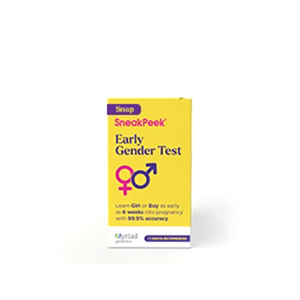Published on August 9th, 2022 and Updated on January 12th, 2024
Check out SneakPeek Gender Test to find out your baby’s gender as early as 6 weeks at over 99% accuracy1!
If you’ve been anxiously trying to get pregnant, it can be tempting to buy an at-home test and head straight for the bathroom. But don’t rip open that package just yet!
Experts recommend taking a pregnancy test no fewer than 3 weeks after you believe you’ve conceived. Drugstore-bought pregnancy tests are most accurate only after you’ve missed your expected period—the earlier you take a test, the less reliable the pregnancy test result can be.
Whether you just have a feeling or have been counting down the days until your period, understanding how pregnancy tests—and our bodies—work can bring a world of comfort while waiting. Let’s talk all things pregnancy test and what you need to know before whipping out that little white wand.
How do at-home pregnancy tests work?
Although some use an ovulation test as a pregnancy test, it is still better to use a pregnancy test. At-home pregnancy tests are designed to detect one hormone in particular: hCG.
hCG, or human chorionic gonadotropin, is a chemical that crops up when a new baby begins growing inside of you. It’s emitted by the tissues found in a human embryo—the earliest stage of a baby’s growth.
When a fertilized egg implants in your uterine wall, the placenta that will later encase your baby begins to form, triggering the release of hCG hormone. Over the first eight weeks of pregnancy, hCG hormone levels don’t just hit the gas pedal—they accelerate, nearly doubling every day.
In the earliest weeks after conception, hCG’s main role is to tell your body, “Hey, we’re pregnant!” Over the course of your first trimester, especially between 8 and 11 weeks, hCG assists with:
- Pausing menstruation
- Thickening the uterine lining
- Creating your placenta
- Promoting fetal growth
- Maintaining estrogen and progesterone levels
So, when can your average at-home pregnancy test pick up on hCG’s signals?
Small amounts of hCG can appear in your body as early as 11 days into a pregnancy. However, for most women, it takes at least two weeks after conception for hCG levels to be high enough for an at-home test to detect.
When are pregnancy tests most accurate?
While plenty of at-home tests flaunt “99% Accuracy!” on their packaging, the truth is that this statistic depends on when they’re used. So, how soon will a pregnancy test read positive?
Most pregnancy tests require your urine’s hCG levels to meet a threshold of 20 to 50 milliliters in your urine stream. The earlier you test, the less likely you are to hit this benchmark.
Because of this, pregnancy test accuracy rates vary considerably in the days leading up to your first missed period:
- 6 days before: 25% accurate result
- 5 days before: 33% accurate result
- 4 days before: 42% accurate result
- 3 days before: 68% accurate result
- 2 days before: 81% accurate result
- 1 day before: 93% accurate result
- Expected day: 96% accurate result
- 1 day after: 99% accurate or higher
Ultimately, knowing when to take a pregnancy test comes down to tracking your menstrual cycle. But if you’re among the 25% of women who have irregular periods, you may yield an inaccurate result—even if you’ve waited those recommended 3 weeks.
Let’s take a look at two scenarios where pregnancy tests can get it wrong: false negative and false positive pregnancy test.
False Negatives and False Positives
For a $20 pregnancy testing kit picked from your local drugstore, most at-home pregnancy tests are remarkably accurate when used as advised.
That said, the FDA estimates that up to 20% of pregnant women get false negative results (meaning, the test indicates you aren’t pregnant when you actually are) when testing on the assumed date of their first missed period.
A false negative result may be caused by:
- Taking the test too early (i.e. accidentally taking the test before the first day of your missed period)
- Misusing the test or checking your results too early
- Using watered-down urine with your test
Getting a false positive result from a pregnancy test is even less common, occurring at a rate of less than 1%. However, it’s not impossible. Usually, a false positive result is caused by:
- Excess protein or blood in your urine
- Certain medications (e.g. aspirin)
- An ectopic pregnancy (implantation that occurs outside the uterus, most commonly in the fallopian tube)
Note that while an ectopic pregnancy is technically a pregnancy, ectopic pregnancies are not viable. They must be medically terminated, otherwise, the mother could risk hemorrhaging and even death.
If you take an at-home test and receive positive test results alongside pelvic pain or bleeding, this may be an indication of an ectopic pregnancy. If you notice these symptoms, contact your OBGYN or healthcare provider right away.
4 Signs You Should Take a Pregnancy Test
Learning to read your body’s cues can be enormously helpful for indicating a brand-new pregnancy.
Here are four reliable signs or pregnancy symptoms that it’s time to take a test:
- Late or missed period – The first pregnancy symptom you might notice easily is a missed or late period. All healthy pregnancies will pause menstruation, so if you’re sexually active and your period misses its monthly appointment, that’s usually the first sign that your beautiful bun is in the oven. The only exceptions to the missed period rule apply to women with irregular cycles or amenorrhea (the complete absence of menstruation), or women who’ve reached menopause.
- Sore breasts – Thanks to those tell-tale hormonal shifts, many women experience sore breasts in early pregnancy. At times, breast swelling and soreness can occur even before tests can accurately detect a bun in the oven!
- Nausea – Ah, the dreaded “morning sickness.” While not clinically proven, research suggests that spiking hCG levels may trigger nausea and vomiting early in the first trimester. Some 70% of pregnant women experience morning sickness, so if you’re feeling queasier than usual, it may be time to take a test.
- Increased urination – Pregnancy increases your body’s blood supply, which means your kidneys must work overtime to filter your blood and excrete excess waste through your urine. If you’ve been making more visits to the bathroom lately, it could be a sign you’re with child.
Should you take a pregnancy test if you’ve bled?
Many women who suspect they’re pregnant notice spotting in their underwear and forgo a test altogether—but this isn’t necessarily a sign that their period has come this month.
Around 25% of women experience implantation bleeding in early pregnancy after a fertilized egg embeds into the lining of their uterus.
While this can be a little scary for hopeful moms, it’s a completely normal process—albeit a an inconvenient one. That’s because implantation bleeding usually lines up with your menstrual week, precisely the ideal time to take that test.
Because of this, it’s important to know how to spot (pun intended) the qualities that differentiate implantation bleeding from your usual period. Implantation bleeding tends to be:
- Light in flow
- Faintly pink- or brown-colored
- Free of tissue or clotted blood
- Mixed with cervical mucus
Implantation typically only lasts for 1 to 2 days, so if your spotting recedes rapidly, it may be a sign to take a test.
Tips for Getting Accurate Pregnancy Test Results
If you get the timing of your pregnancy test right, the most difficult part is over, but there are some tricks of the trade that can improve the accuracy of your test results.
Once your test date rolls around, keep these testing tips top of mind:
- Test in the AM – The best time of day to take a pregnancy test is right after you wake up in the morning when your hCG levels are at their highest.
- Hydrate (but don’t go crazy) – You need hydration to provide a urine sample, but don’t go overboard! Chugging water will leave you with diluted urine, which can lower its hCG levels and increase your chances of getting a false negative.
- Unbox right before use – Much like the avocado in your fridge, pregnancy tests can also “go bad”. Unused testing stick accuracy declines when left out in the open, so be sure to use yours right after you unwrap.
- Inventory your medications – Some drugs, particularly hormonal medications like Clomid, Menopur, and Pergonal, can compromise the accuracy of pregnancy tests. For an extra dose of confidence, check with your healthcare provider to see if any medications you use may affect test results.
- Repeat your test – No matter what answer you receive, it’s always best to double check your test results. Even though tests claim 99% accuracy after your first missed period, studies show that up to 5% of negative results are inaccurate—even when the test is used correctly. To confirm your results, experts recommend testing again one week after your first test.
Take The Next Testing Step With SneakPeek
For moms-to-be anxious to hear news of their growing little one, there’s a lot riding on that plastic wand. If you do wind up with a “Pregnant” or plus sign, the excitement has just begun!
In early pregnancy, your mind will be dizzy with questions about your precious little bundle like, will they become a beautiful girl or boy?
SneakPeek’s At-Home Gender Blood Test lets you discover your baby’s gender from the comfort of home as early as 6 weeks into your pregnancy—that’s months earlier than your 20-week anatomy ultrasound! With over 99% clinically proven accuracy1, complete privacy protection, and a money-back guarantee, we’re trusted by 1 million moms—and we’re the #1 at-home gender test recommended by OBGYN professionals.
Take the next exciting step towards meeting your little one and order your SneakPeek Test kit today.
This post has been reviewed for accuracy by the following medical professionals:
Dr. Heather Soper, Certified Nurse Midwife
Dr. Heather Soper brings over 15 years of experience in women's health and obstetrics to her role as the owner of The Genesis Resort for Birth. Complementing her clinical practice, she serves as an Assistant Professor of Nursing at James Madison University, where she educates nursing students with a focus on compassionate, patient-centered care. Her advanced training and dedication to midwifery are evident in her contribution to both academia and the wellness of expectant mothers
Katie Smith is a seasoned Certified Nurse Midwife and a nurturing mother to six children, offering a unique blend of professional expertise and personal experience. She is the founder of Birth Your Way Midwifery and Women’s Wellness Center in Bay County, Florida. Katie's comprehensive approach to care is informed by her hands-on experience in motherhood and her passion for empowering women through their birthing journey. Her dedication extends beyond her center as she actively engages in community wellness and family health education.
Sources:
- National Library of Medicine. Human Chorionic Gonadotropin. https://www.ncbi.nlm.nih.gov/books/NBK532950/
- Cleveland Clinic. Human Chorionic Gonadotropin. https://my.clevelandclinic.org/health/articles/22489-human-chorionic-gonadotropin
- American Pregnancy Association. What is hCG? https://americanpregnancy.org/getting-pregnant/hcg-levels/
- The Ohio State University. When is the best time to take a pregnancy test? https://health.osu.edu/health/sexual-health/best-time-to-take-pregnancy-test
- VeryWell Family. When to Take a Pregnancy Test. https://www.verywellfamily.com/when-is-the-best-time-to-take-an-early-pregnancy-test-1960163
- National Library of Medicine. How many women are affected by menstrual irregularites? https://www.nichd.nih.gov/health/topics/menstruation/conditioninfo/affected
- Food and Drug Administration. Pregnancy. https://www.fda.gov/medical-devices/home-use-tests/pregnancy
- Mayo Clinic. Home pregnancy tests: Can you trust the results? https://www.mayoclinic.org/healthy-lifestyle/getting-pregnant/in-depth/home-pregnancy-tests/art-20047940
- Cleveland Clinic. Morning Sickness with Pregnancy: Causes, Treatment & Prevention. https://my.clevelandclinic.org/health/diseases/16566-morning-sickness-nausea-and-vomiting-of-pregnancy
- Cleveland Clinic. Am I Pregnant? Early Symptoms of Pregnancy & When To Test. https://my.clevelandclinic.org/health/articles/9709-pregnancy-am-i-pregnant
- NIH. Patterns and predictors of vaginal bleeding in the first trimester of pregnancy. https://www.ncbi.nlm.nih.gov/pmc/articles/PMC2884141/
- ClearBlue. All you need to know about implantation bleeding. https://www.clearblue.com/am-i-pregnant/implantation-bleeding
- VeryWell Family. Tips for Taking a Pregnancy Test. https://www.verywellfamily.com/how-to-take-pregnancy-test-tips-2759713
- Washington University School of Medicine in St. Louis. Flaw in many home pregnancy tests can return false negative results. https://medicine.wustl.edu/news/flaw-in-many-home-pregnancy-tests-can-return-false-negative-results/
- VeryWell Family. How Long Should I Wait Between Pregnancy Tests? https://www.verywellfamily.com/how-long-should-i-wait-between-pregnancy-tests-2759848
- Parents Magazine. Your Chances of Getting Pregnant Every Day of the Month. https://www.parents.com/getting-pregnant/trying-to-conceive/ovulation-getting-pregnant/
- Planned Parenthood. Pregnancy Tests. https://www.plannedparenthood.org/learn/pregnancy/pregnancy-tests
- Research Gate. Arrhythmic risk during pregnancy and postpartum in patients with long QT syndromeArrhythmierisiko während der Schwangerschaft und nach der Geburt bei Patientinnen mit Long-QT-Syndrom. https://www.researchgate.net/figure/ariation-in-female-hormone-levels-during-the-menstrual-cycle-a-and-during-pregnancy-and_fig1_350479950
- The Ohio State University. When is the best time to take a pregnancy test? https://health.osu.edu/health/sexual-health/best-time-to-take-pregnancy-test
- The Source. 7 Reasons Your Pregnancy Test Gave A False-Positive. https://www.thesource.org/post/reasons-your-pregnancy-test-gave-a-false-positive
- VeryWell Family. Tips for Taking a Pregnancy Test. https://www.verywellfamily.com/how-to-take-pregnancy-test-tips-2759713
- VeryWellMind. Stages of Prenatal Development. https://www.verywellmind.com/stages-of-prenatal-development-2795073
- The Source. 7 Reasons Your Pregnancy Test Gave A False-Positive. https://www.thesource.org/post/reasons-your-pregnancy-test-gave-a-false-positive
- CDC. Substance abuse during pregnancy. https://www.cdc.gov/reproductivehealth/maternalinfanthealth/substance-abuse/substance-abuse-during-pregnancy.htm

Shop Our Products
SneakPeek aims to provide the most accurate and up-to-date information to help our readers make informed decisions regarding their health before, during, and after pregnancy. This article was written based upon trusted scientific research studies and/or articles. Credible information sources for this article are cited and hyperlinked.







